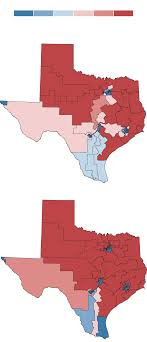Texas Redistricting in 2025: Analyzing Changes to Congressional and Legislative Boundaries
As of August 2025, Texas is immersed in a mid-cycle redistricting effort, with the primary focus directed toward revising its congressional districts. This initiative was triggered by a significant federal court decision in Petteway v. Galveston County, handed down by the 5th U.S. Circuit Court of Appeals in late 2024. The ruling struck down the use of “coalition districts” under Section 2 of the Voting Rights Act, where multiple minority groups (such as Black and Latino voters) were combined to form majority-minority districts—a practice Republicans claimed constituted racial gerrymandering. This decision paves the way for Texas to redesign its maps, aiming for “color-blind” districts that emphasize compactness and community cohesion over racial considerations. Additionally, President Trump has encouraged the process to secure five additional Republican seats, capitalizing on population shifts from the 2020 census that have bolstered growth in Republican-leaning suburban regions.
Importantly, this redistricting effort is confined to congressional boundaries; there are no broad updates to the state House or Senate maps in 2025. The 2021 state legislative maps, implemented through S.B. 4 for the Senate and H.B. 1 for the House, remain in place, as verified by the Texas Legislative Council’s redistricting portal, which indicates no new proposals beyond minor tweaks stemming from ongoing legal challenges. These 2021 maps were crafted to account for population increases, with the Senate map (PLAN S2168) preserving 31 districts and the House map (PLAN H2316) encompassing 150 districts. Concerns about gerrymandering in state maps, such as the dilution of urban minority votes in Dallas-Fort Worth from 2021, persist unchanged in the absence of 2025 revisions.
The spotlight here shifts to the congressional map, where substantial alterations are underway. The proposed 2025 map (draft plan C2308, evaluated by the Princeton Gerrymandering Project) seeks to align with traditional redistricting standards, such as compactness and respect for political subdivisions, while moving away from what Republicans consider racially driven gerrymandering in the 2021 configuration. Although Democrats criticize the plan for solidifying Republican dominance, supporters assert it diminishes reliance on racial data, fostering fairer representation by letting natural political alignments take shape. The Princeton Gerrymandering Project assigns the 2025 draft an “F” for partisan fairness due to a notable Republican edge but acknowledges enhancements in geographic design (e.g., fewer irregular shapes) compared to the 2021 map, which also received a poor grade but featured more stretched districts to support coalitions.
Notable Enhancements in the 2025 Congressional Map
The 2021 map, established post-2020 census, increased Texas’ congressional seats to 38 (from 36) due to population growth, yielding a 25-13 Republican-Democratic split. However, it faced challenges for employing coalition districts that allegedly prioritized race, resulting in oddly configured districts that fragmented urban minority populations. The 2025 proposal adjusts to 30 Republican-leaning seats and 8 Democratic ones, more accurately mirroring Texas’ statewide political tilt (Republicans garnered approximately 53% of the vote in the 2024 presidential election). By abandoning coalition strategies, the updated map offers:
• Increased Compactness: Districts are now more geographically consistent, minimizing “spaghetti-like” configurations that spanned county lines to consolidate minorities.
Keep reading with a 7-day free trial
Subscribe to The Houston Comical to keep reading this post and get 7 days of free access to the full post archives.

